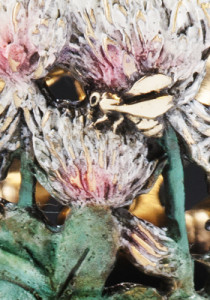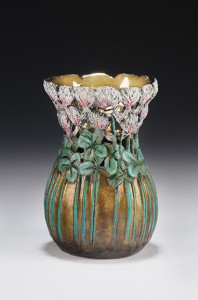Eight years ago, the U.S. Senate’s unanimous approval and designation of a week in June as “National Pollinator Week” marked a necessary step toward addressing the urgent issue of declining pollinator populations. The U.S. Secretary of Agriculture signs the proclamation every year. This year’s Pollinator Week will take place June 15-21, 2015. Plant your pollinator friendly (pesticide free) garden – speak with your children and grandchildren about the beautiful gifts our pollinators provide and make this not only a week of awareness, but a new year of a personal commitment to doing all you are able to do to protect them.
Nature’s Bounty, is a very small piece, not unlike the honeybee. Amidst a field of white clover, one solitary honeybee visits the clover – one tiny (and difficult to find without intention) honeybee symbolic of how easy it is for us to overlook them in nature as well. The textural base of the piece was created using actual honeycomb from a hive of bees my brother tends on our family farm in PA. Each time we sell a Nature’s Bounty from the studio, we donate a portion (between 10 and 30%) of the sale to one of the organizations helping support our pollinators via education, research and other efforts. Often we support Pollinator Partnership with these donations; or an organization of the collector’s choice.
During the month of June the studio will again offer complimentary packing and shipping (within the USA), in honor of National Pollinator’s Week. As always, we will also place a donation, in your honor, at your choice of organizations supporting efforts to insure the future of our pollinators.


 This is National Pollination Week – a week for not only celebration but even more so a welcome reminder to create lifestyle choices and habits that protect our beloved and vital pollinators. Six years ago the U.S. Senate’s unanimous approval and designation of a week in June as “National Pollinator Week” marked a necessary step toward addressing the urgent issue of declining pollinator populations. Pollinator Week has now grown to be an international celebration of the valuable ecosystem services provided by bees, birds, butterflies, bats and beetles. The growing concern for pollinators is a sign of progress, but it is vital that we continue to maximize our collective effort. The U.S. Secretary of Agriculture signs the proclamation every year.
This is National Pollination Week – a week for not only celebration but even more so a welcome reminder to create lifestyle choices and habits that protect our beloved and vital pollinators. Six years ago the U.S. Senate’s unanimous approval and designation of a week in June as “National Pollinator Week” marked a necessary step toward addressing the urgent issue of declining pollinator populations. Pollinator Week has now grown to be an international celebration of the valuable ecosystem services provided by bees, birds, butterflies, bats and beetles. The growing concern for pollinators is a sign of progress, but it is vital that we continue to maximize our collective effort. The U.S. Secretary of Agriculture signs the proclamation every year. 








